Walt Disney World Railroad
The Walt Disney World Railroad (WDWRR) is a 3-foot (914 mm) narrow-gauge heritage railroad and attraction located within the Magic Kingdom theme park of Walt Disney World in Bay Lake, Florida, in the United States. Its route is 1.5 miles (2.4 km) in length and encircles most of the park, with train stations in three different park areas. The rail line, constructed by WED Enterprises, operates with four historic steam locomotives originally built by Baldwin Locomotive Works. It takes about 20 minutes for each train to complete a round trip on the WDWRR's main line loop. On a typical day, the railroad has two trains in operation; on busy days, it has three trains.
| Walt Disney World Railroad | |
|---|---|
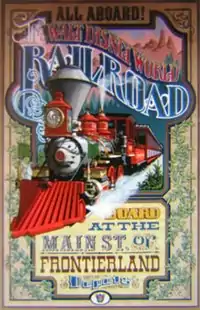 The attraction poster for the WDWRR | |
| Magic Kingdom | |
| Coordinates |
|
| Status | Under construction |
| Opening date | October 1, 1971 |
| General statistics | |
| Attraction type | Railroad |
| Manufacturer | Baldwin Locomotive Works |
| Designer | WED Enterprises |
| Vehicle type | Train |
| Vehicles | |
| Riders per vehicle | 375 per train |
| Duration | About 20:00 |
| No. of tracks | Single |
| Track gauge | 3 ft (914 mm) |
| Track length | 1.5 miles (2.4 km) |
| Sponsor | Auto-Train Corporation (1976–1977) |
The WDWRR's development was led by Roger E. Broggie, who also oversaw the construction of the Disneyland Railroad in Disneyland in Anaheim, California. The attraction's locomotives were acquired from the Ferrocarriles Unidos de Yucatán, a narrow-gauge railroad system in Mexico. After being shipped to the United States, they were altered to resemble locomotives built in the 1880s and restored to operating condition. Each locomotive was also given a set of passenger cars, which were built from scratch.
The WDWRR opened to the public for the first time on October 1, 1971, the same day that the Magic Kingdom park opened. Since then, the WDWRR has become one of the world's most popular steam-powered railroads, with about 3.7 million passengers each year. The WDWRR closed temporarily on December 3, 2018, due to the construction of the Tron Lightcycle Run roller coaster attraction near the Tomorrowland section.
History
Discovery in Mexico
.jpg.webp)
The development of the Walt Disney World Railroad (WDWRR) from the late 1960s to its opening in 1971 was overseen by Roger E. Broggie, vice president and general manager of Mapo, Inc., WED Enterprises' research and manufacturing branch.[1] Broggie previously supervised the building of the Disneyland Railroad in Disneyland in Anaheim, California.[1][2] From his experience with the railroad at Disneyland, Broggie determined that it was better to use existing steam locomotives, rather than building them entirely from scratch like the Disneyland Railroad's first two locomotives.[1] To this end, he contacted rail historian Gerald M. Best who informed him that locomotives could be obtained at a railroad boneyard in Mérida, Yucatán, Mexico, owned by the Ferrocarriles Unidos de Yucatán.[3][4] This was a 3 ft (914 mm) narrow-gauge system, the same gauge as the Disneyland Railroad.[4] Broggie, along with fellow Disney employee and railroad-building expert Earl Vilmer, went to Mérida in 1969 to investigate.[4] They determined that four locomotives built by Baldwin Locomotive Works could potentially be salvaged, along with a fifth locomotive built by Pittsburgh Locomotive and Car Works, which was in front of the railroad company's headquarters.[4]
Broggie paid a total of US$32,750 for all five locomotives ($8,000 for each of the four locomotives in the boneyard plus an additional $750 for the fifth locomotive).[4][5] The locomotives, along with an assortment of brass fittings and other spare parts given away for free, were immediately shipped by rail back to the United States.[6]
Restoration in Florida
Walt Disney World Railroad | |||||||||||||||||||||||||||||||||||||||||||||||||||||||||||||||||||||||||||||||||||||||||||||||||||||||
|---|---|---|---|---|---|---|---|---|---|---|---|---|---|---|---|---|---|---|---|---|---|---|---|---|---|---|---|---|---|---|---|---|---|---|---|---|---|---|---|---|---|---|---|---|---|---|---|---|---|---|---|---|---|---|---|---|---|---|---|---|---|---|---|---|---|---|---|---|---|---|---|---|---|---|---|---|---|---|---|---|---|---|---|---|---|---|---|---|---|---|---|---|---|---|---|---|---|---|---|---|---|---|---|
| |||||||||||||||||||||||||||||||||||||||||||||||||||||||||||||||||||||||||||||||||||||||||||||||||||||||
The five locomotives and spare parts acquired by Roger Broggie were sent to the Tampa Ship Repair & Dry Dock Company in Tampa, Florida, to receive the aesthetic and mechanical restorations necessary to run on the planned WDWRR.[6] At the time, this was the closest facility to the Walt Disney World site in Bay Lake, Florida with the space and equipment needed to accommodate full-size railroad rolling stock.[6][7] Here, Transportation Superintendent Earl Vilmer, who had accompanied Broggie on his trip to Mexico, along with Project Engineer Bob Harpur and the facility's Machinist Supervisor George Britton, were tasked with the project's completion.[8][9]
The general idea for the restoration was to make the locomotives appear as if they were built in the 1880s.[9] The original, dilapidated boilers of the four locomotives built by Baldwin Locomotive Works were replaced with new, smaller boilers built by Dixon Boiler Works.[9][10] Their worn-out wood and steel cabs were replaced with new ones made of fiberglass, and they were given new tenders, which used the trucks from the originals.[5][9] Many of the smaller original parts on the locomotives such as the domes and brass bells on top of the boilers, the wheels, and the side rods were successfully refurbished and retained.[5][10] The locomotives' fireboxes were also modified to burn diesel oil.[10] Replicas of their builder plates were also made to replace the originals.[11]
The Pittsburgh Locomotive and Car Works locomotive acquired along with them could not be restored.[10] Built in 1902, this locomotive was the oldest of the five locomotives purchased and was determined to have too many problems to be rebuilt.[4][10] It was stored out of use in California for a period before being sold to an unknown locomotive broker.[10] Some of its parts were used to help restore the four Baldwin locomotives, including its smokestack, which was fitted to the WDWRR's No. 4 locomotive.[12]
Opening to present day
The restoration of the WDWRR's four locomotives, as well as the construction of five new open-air Narragansett-style excursion cars for each of them (twenty in total), was completed in less than two years.[13] The first completed set of five passenger cars was delivered to the Magic Kingdom park during April 1971 and the first completed locomotive arrived on May 15, 1971, several months before the park's opening.[14][15] Like the steam trains running on the Disneyland Railroad during Disneyland's opening day on July 17, 1955, the steam trains for the WDWRR were the first attraction in the Magic Kingdom park to be finished, and they have been operating in the park ever since it opened on October 1, 1971.[16] George Britton, who was instrumental in getting the WDWRR's locomotives refurbished, became the railroad's foreman from the time the railroad opened until his retirement on April 6, 2006.[17][18] The WDWRR would eventually become one of the most popular steam-powered railroads in the world with about 3.7 million passengers each year.[19]
For the first few months after the WDWRR opened to the public, Main Street, U.S.A. Station at the Magic Kingdom park's entrance, modeled after the former Victorian-style Saratoga Springs station in Saratoga Springs, New York, was the only stop for passengers along its route, making only complete round trips possible.[20][21][22] On May 1, 1972, the first Frontierland Station opened just northwest of Pecos Bill Tall Tale Inn and Café in the Frontierland section on the park's western edge.[23][24] It was one of the last changes made to the WDWRR prior to the retirement of Roger Broggie on October 1, 1973.[25] Frontierland Station was demolished in November 1990 to make way for the new Splash Mountain attraction and was replaced by the current Frontierland Station, which opened in December 1991 just north of the original station site.[26] During construction of the Splash Mountain attraction and the current Frontierland Station, the WDWRR was temporarily renamed Backtrack Express and operated a single train, which only traveled back and forth along the section of track between the Main Street, U.S.A. section and the Mickey's Starland section.[27] Between 1976 and 1977, the Auto-Train Corporation sponsored the WDWRR.[28]
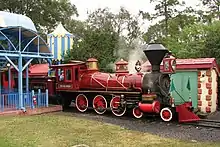
The WDWRR's third station, Mickey's Birthdayland Station, opened on June 18, 1988, in the Magic Kingdom park's brand-new Mickey's Birthdayland section adjacent to the Fantasyland section in the park's northeast corner, and the railroad was briefly renamed Mickey's Birthdayland Express to promote it.[29][30][31] When the Mickey's Birthdayland section was renamed Mickey's Starland in 1990 and Mickey's Toontown Fair in 1996, the signage for its WDWRR station changed both times, but the station's structure remained the same.[31][32] In 2004, the station was demolished and completely rebuilt with an identical appearance to the original station.[31][33] On February 11, 2011, the Mickey's Toontown Fair section closed to make way for the new Storybook Circus area, part of a new expansion of the Fantasyland section.[34] The current Fantasyland Station, built on the site of the former Mickey's Toontown Fair Station, opened on March 12, 2012.[35][36] In April 2012, the water tower and maintenance buildings adjacent to Fantasyland Station were re-themed to match the station's new design.[37] On December 3, 2018, the WDWRR temporarily closed to accommodate construction of the Tron Lightcycle Run roller coaster attraction in the Tomorrowland section.[38][39][40]
Ride experience
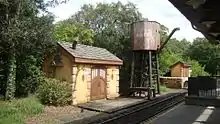
Beginning at Main Street, U.S.A. Station adjacent to the Magic Kingdom park's entrance, the trains of the WDWRR travel along its single track in a clockwise direction on its circular route.[41] It takes about 20 minutes for each train to complete a round trip on the WDWRR's main line, and on any given day, either two or three trains run, with two running on a typical day.[42][43] Each train is operated by an engineer and fireman in the locomotive, as well as a conductor at the rear of the train who supervises the passengers.[44][45]:4–5
As the train departs Main Street, U.S.A. Station, it crosses an access road in the Adventureland section, travels over a small bridge, enters a small tunnel, then crosses a second access road in the Frontierland section.[46] After entering a tunnel through the Splash Mountain log flume attraction, the train stops at Frontierland Station.[46][47]
Continuing down the line, the train passes the Big Thunder Mountain Railroad mine train roller coaster attraction and traverses a fully functional swing bridge, which crosses a canal connecting the Rivers of America to a dry dock area.[48][49] This bridge was originally located in Wabasso, Florida, and was previously owned by the Florida East Coast Railway.[50] The train then runs through an area where numerous static and Audio-Animatronic displays of Native Americans and wild animals can be seen.[51][52] After that, the train goes under an overpass, passes the spur line leading to the WDWRR's roundhouse where its trains are stored and maintained, and arrives at its next stop at Fantasyland Station.[19][52][53]
In the final segment of the train's journey around the park, it climbs a two-percent grade through the Tomorrowland section, passes the Space Mountain roller coaster attraction, and travels over a small bridge before it arrives back at Main Street, U.S.A. Station.[45]:4[54] This completes what the park refers to as The Grand Circle Tour.[55]
- Walt Disney World Railroad stations
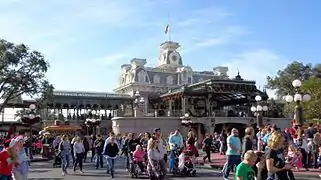 Main Street, U.S.A. Station
Main Street, U.S.A. Station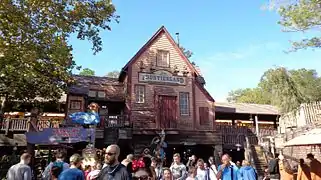 Frontierland Station
Frontierland Station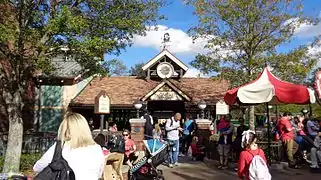 Fantasyland Station
Fantasyland Station
The WDWRR does not run during fireworks shows, given that its track runs close to the fireworks staging area.[43] Since 1999, a separately-priced tour of the WDWRR named Disney's The Magic Behind Our Steam Trains Tour has been available once daily, and includes access to the railroad's otherwise-restricted roundhouse.[19][45]:2[56]
Rolling stock
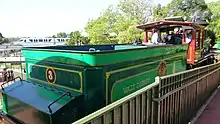
When working on the line, each WDWRR locomotive consumes 25 US gallons (95 l) of fuel and 200 US gallons (760 l) of water per hour, and each tender can hold 664 US gallons (2,510 l) of fuel and 1,837 US gallons (6,950 l) of water.[16][57] In the past, all four locomotives received overhauls at the Tweetsie Railroad in Blowing Rock, North Carolina.[45]:5 Each of the four locomotives pulls a set of five passenger cars with seating capacity for 75 passengers per car, for a total of 375 passengers per train.[13] Steam-driven generators at the rear of the tenders supply electricity to the locomotives and passenger cars.[58] The locomotives do not contain brakes, but the passenger cars do.[45]:5
| Number | Name | Namesake | Image | Wheel arrangement | Date built | Builder | Serial number | Passenger cars | Date entered service | Notes |
|---|---|---|---|---|---|---|---|---|---|---|
| 1 | Walter E. Disney | Walt Disney |  |
4-6-0 (Ten wheeler) | May 1925 | Baldwin Locomotive Works | 58444 | Five red passenger cars (100 series) |
October 1, 1971 | This is the WDWRR's tallest locomotive at 11 feet 11 inches (3.6 m), giving it 1 inch (25 mm) of clearance between the top of its smokestack and the top of the roundhouse doors.[13] |
| 2 | Lilly Belle | Lillian Disney |  |
2-6-0 (Mogul) | September 1928 | Baldwin Locomotive Works | 60598 | Five green passenger cars (200 series) |
October 1, 1971 | After a multi-year refurbishment, this locomotive returned to service in late 2016.[61] |
| 3 | Roger E. Broggie | Roger E. Broggie |  |
4-6-0 (Ten wheeler) | May 1925 | Baldwin Locomotive Works | 58445 | Five yellow passenger cars (300 series) |
October 1, 1971 | Originally planned to be named after Roy O. Disney, but given that he did not want his name attached to the locomotive nearly identical to the No. 1 named after Walt Disney, the No. 4 was named after him instead.[14] |
| 4 | Roy O. Disney | Roy O. Disney | 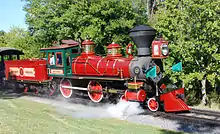 |
4-4-0 (American) | February 1916 | Baldwin Locomotive Works | 42915 | Five blue passenger cars (400 series) |
December 1, 1971 | Predates the Magic Kingdom's oldest purpose-built amusement attraction: the Prince Charming Regal Carrousel, built in 1917.[62][63] This locomotive's service entry date was delayed until two months after the park opened to make a major repair to its frame.[14] |
Block signals
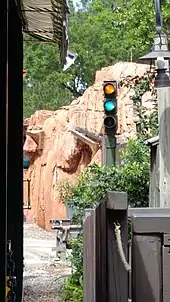
The WDWRR uses block signals to notify the engineers, firemen, and conductors on each train whether the track segments along the railroad's 1.5 miles (2.4 km) of main-line track are clear or occupied by other trains.[19][42][45]:5 They are also used to notify WDWRR personnel when Big Thunder Mountain Railroad's transfer track is swung over the WDWRR's track to transfer trains on and off the roller coaster.[42] The WDWRR's track is divided into seven such segments, or blocks, and each block has a track-side block signal to communicate its status.[42][64] Block signals are located at each of the three stations, alongside the three main-line blocks between the stations, and alongside the spur line connecting the WDWRR's roundhouse to the main line.[42][64]
| Block signal light color(s) | Meaning | Action needed (when two trains are operating) |
Action needed (when three trains are operating) | ||
|---|---|---|---|---|---|
| Next block is occupied | Stop | Stop | |||
| |
Next two blocks are occupied | Stop | Stop | ||
| |
Next block is clear, but following block is occupied | Stop | Proceed to next block | ||
| Next two blocks are clear | Proceed to next block | Proceed to next block |
See also
References
- Broggie (2014), p. 317.
- Broggie (2014), p. 216.
- Broggie (2014), p. 318.
- Broggie (2014), pp. 320–323.
- Amendola (2015), pp. 148–149.
- Broggie (2014), p. 324.
- "Bay Lake, Florida". City-Data. Archived from the original on June 10, 2016. Retrieved July 28, 2017.
- Broggie (2014), p. 328.
- Leaphart (2016), pp. 104–106.
- Broggie (2014), p. 329.
- Leaphart (2016), p. 33.
- Leaphart (2016), p. 66.
- Broggie (2014), p. 331.
- Leaphart (2016), pp. 130–131.
- "May 15, 1971: Walt Disney World Railroad". Orlando Sentinel. May 15, 1971. Archived from the original on June 22, 2016. Retrieved July 21, 2016.
- Broggie (2014), p. 333.
- Broggie, Michael (Spring 2006). "Veteran Disney Railroader to Retire" (PDF). Carolwood Chronicle. Carolwood Pacific Historical Society. p. 1. Archived from the original (PDF) on October 1, 2016. Retrieved January 24, 2019.
- Shafer, Bill (April 6, 2006). "End of Line for Disney's Train Conductor". WESH. Archived from the original on November 14, 2007. Retrieved June 17, 2019.
- Grant, Rich (March 18, 2015). "How Walt Disney's Love of Trains Changed the World". HuffPost. Archived from the original on March 18, 2016. Retrieved June 19, 2016.
- "Walt Disney World Railroad Main Street U.S.A. Station". TouringPlans.com. Archived from the original on June 30, 2016. Retrieved January 14, 2017.
- Mongello, Lou (September 14, 2007). "Main Street, U.S.A". WDWRadio. Archived from the original on January 14, 2017. Retrieved January 14, 2017.
- Leaphart (2016), p. 177.
- "Walt Disney World Railroad Frontierland Station". TouringPlans.com. Archived from the original on June 30, 2016. Retrieved January 14, 2017.
- Korkis (2016), p. 3.
- Broggie (2014), p. 131.
- Mongello, Lou (September 14, 2007). "Frontierland Trivia". WDWRadio. Archived from the original on January 14, 2017. Retrieved January 14, 2017.
- "Off Track. Even Disney World Admits It..." Orlando Sentinel. November 26, 1990. Archived from the original on March 17, 2019. Retrieved March 17, 2019.
- Crawford (2015), p. 118.
- "Walt Disney World Railroad Fantasyland Station". TouringPlans.com. Archived from the original on June 30, 2016. Retrieved January 14, 2017.
- Mongello, Lou (February 9, 2005). "Mickey's Something-Land..." WDWRadio. Archived from the original on January 14, 2017. Retrieved January 14, 2017.
- Burns, Steve (Fall 2004). "Mickey's Toontown Fair" (PDF). Carolwood Chronicle. Carolwood Pacific Historical Society. p. 3. Archived from the original (PDF) on December 4, 2018. Retrieved January 25, 2019.
- Leaphart (2016), pp. 172–174.
- "Toontown Train Station Refurbishment". WDWMagic.com. May 24, 2004. Archived from the original on April 3, 2016. Retrieved April 12, 2017.
- "A Look at the Closing of Mickey's Toontown Fair". Attractions Magazine. February 12, 2011. Archived from the original on September 11, 2014. Retrieved January 14, 2017.
- "Storybook Circus in Magic Kingdom's Fantasyland Soft Opens". easyWDW. March 12, 2012. Archived from the original on April 15, 2017. Retrieved April 20, 2017.
- MacDonald, Brady (March 14, 2012). "Disney World Opens First Phase of Fantasyland Expansion". Los Angeles Times. Archived from the original on March 21, 2019. Retrieved March 21, 2019.
- "Photos – Fantasyland Train Station Gets Newly Themed Water Tower and Out-Buildings". WDWMagic.com. April 4, 2012. Archived from the original on August 5, 2014. Retrieved April 11, 2017.
- Bevil, Dewayne (November 29, 2018). "Disney: Last Call for Magic Kingdom Train Rides". Orlando Sentinel. Archived from the original on November 30, 2018. Retrieved December 1, 2018.
- Williams, Kevin (November 30, 2018). "Magic Kingdom Rides Closing: Walt Disney World Railroad to Shut Down for a While; Tomorrowland Speedway Is Next". WFTV. Archived from the original on December 1, 2018. Retrieved December 1, 2018.
- Carter, Ashley (August 23, 2019). "Tron Coaster Vehicle on Display at Disney's D23 Expo". News 13. Archived from the original on August 25, 2019. Retrieved August 25, 2019.
- Mongello, Lou (September 14, 2007). "Magic Kingdom and Fun Facts". WDWRadio. Archived from the original on January 9, 2012. Retrieved June 19, 2016.
- Leaphart (2016), pp. 166–167.
- Kirk, Kristen (October 6, 2015). "Take A Break On The Walt Disney World Railroad". Walt Disney World For Grownups. Archived from the original on October 9, 2015. Retrieved April 12, 2017.
- Conradt, Stacy (October 1, 2008). "The Quick 10: 10 Magic Kingdom Attractions and Their Secrets". Mental Floss. Archived from the original on November 1, 2015. Retrieved June 19, 2016.
- Withers, Bob (January 2010). "This Is a Mickey Mouse Railroad!" (PDF). Trains. Kalmbach Publishing. Archived from the original (PDF) on October 8, 2016. Retrieved May 19, 2017.
- Leaphart (2016), pp. 154–157.
- Corsello, Caitlin (July 7, 2014). "Disney from the Twenty-Something: "Walt Disney World Railroad"". WDWRadio. Archived from the original on March 1, 2019. Retrieved March 9, 2019.
- Leaphart (2016), pp. 158–159.
- Korkis (2016), p. 4.
- Leaphart (2016), pp. 148–149.
- Daly, Sean (September 28, 2011). "Celebrate 40th Birthday of Walt Disney's Magic Kingdom (and Check Out These 'Secret' Spots)". Tampa Bay Times. Archived from the original on July 31, 2013. Retrieved June 19, 2016.
- Eades, Mark (May 17, 2017). "A Former Disney Imagineer's Guide to Walt Disney World's Frontierland". Orange County Register. Archived from the original on December 12, 2018. Retrieved March 13, 2019.
- Leaphart (2016), pp. 160–161.
- Leaphart (2016), pp. 162–165.
- "Walt Disney World Railroad". Theme Park Insider. December 12, 2013. Archived from the original on September 5, 2015. Retrieved June 19, 2016.
- "Disney's The Magic Behind Our Steam Trains Tour – official website". Walt Disney Parks and Resorts. Archived from the original on March 22, 2016. Retrieved June 25, 2016.
- Broggie (2014), pp. 393–394.
- Leaphart (2016), p. 197.
- Amendola (2015), pp. 150–157.
- Leaphart (2016), pp. 121–129.
- "Lilly Belle Train Returns to the Walt Disney World Railroad". WDWThemeParks.com. November 24, 2016. Archived from the original on April 10, 2017. Retrieved April 15, 2017.
- "Prince Charming Regal Carrousel – official website". Walt Disney Parks and Resorts. Archived from the original on April 18, 2016. Retrieved June 19, 2016.
- Leibacher, Herb (July 18, 2016). "Let's Take a Look at Disney's Oldest Original Ride". World of Walt. Archived from the original on April 14, 2017. Retrieved April 14, 2017.
- Leaphart (2016), p. 152.
Bibliography
- Amendola, Dana (2015). All Aboard: The Wonderful World of Disney Trains (1st ed.). Disney Editions. ISBN 978-1-4231-1714-8.
- Broggie, Michael (2014). Walt Disney's Railroad Story: The Small-Scale Fascination That Led to a Full-Scale Kingdom (4th ed.). The Donning Company Publishers. ISBN 978-1-57864-914-3.
- Crawford, Michael (2015). The Progress City Primer (1st ed.). Progress City Press. ISBN 978-0-9862050-6-4.
- Korkis, Jim (2016). More Secret Stories of Walt Disney World: More Things You Never Knew You Never Knew (1st ed.). Theme Park Press. ISBN 978-1-68390-022-1.
- Leaphart, David (2016). Walt Disney World Railroads Part 3: Yucatan Jewels (1st ed.). Steel Wheel on Steel Rail Studio. ISBN 978-1-533-03707-7.
External links
| Wikimedia Commons has media related to Walt Disney World Railroad. |
- Official website

 Geographic data related to Walt Disney World Railroad at OpenStreetMap
Geographic data related to Walt Disney World Railroad at OpenStreetMap